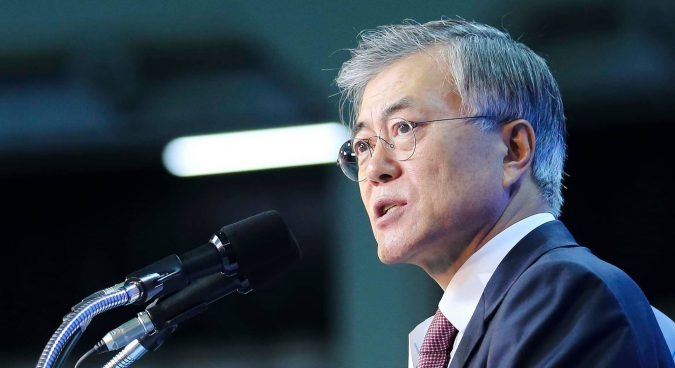After an election triggered by its last president’s impeachment, South Korea has a new leader, the Democratic Party’s Moon Jae-in. After the scandal that brought down his predecessor, he campaigned largely against corruption and on economic issues – but he was also forced to explain how he would handle his country’s northern neighbour.
During the last weeks of the election campaign, North Korea ramped up its missile tests and even hinted at an upcoming nuclear test. Experts and military officials said that the recent tests indicated that the country’s missile capabilities are advancing fast, and that Pyongyang could soon be able to fit a nuclear warhead onto an intercontinental ballistic missile.
As a result, some are concerned that a devastating war on the Korean peninsula might be in the offing. Should such a conflict erupt, it could turn out to be more intensive than any war the region has seen, even though the US and South Korea can reportedly intercept at least some North Korean missiles with their newly deployed Terminal High Altitude Area Defence (THAAD) system.
And yet, for almost four decades, East Asia has been more peaceful than Europe, the Americas, or any other continent, at least if peacefulness is measured by the number of conflict fatalities per head of population. So why is this the case – and might recent events on the Korean Peninsula put an end to this remarkably stable era?
One recent study found that one of the main reasons East Asia remains overwhelmingly peaceful is that almost all its states believe their number one job is to foster economic development at home. Most of them have duly pursued growth and development with something bordering on obsession. This naturally makes them reluctant to fight wars, which would by definition disrupt the economic interdependence that has helped make them so wealthy so fast.
There is clear evidence to back up this hypothesis: after World War II, those East Asian countries where the regime did not consider development a top priority saw on average more than 300 times as many conflict fatalities per million people as countries that put development first. After the 1970s, most countries became “developmentalist”, and North Korea is now a glaring exception.
Easing the tension
Broadly speaking, the rest of East Asia now operates under a norm of military non-interference in the internal affairs of other countries. This is a stark contrast with the practice before the end of the Vietnam War, when wars in Korea, Laos, Cambodia, the Philippines, China, and elsewhere saw other countries offer ideologically driven support to both governments and their opponents.
The effect of this support is evident in the data. After World War II, two-thirds of East Asia’s conflict fatalities were caused by conflicts that started out as civil wars but were then internationalised when outside powers interfered – and in these wars, the internationalisation intensified killings by a factor of 20.
As the years went by, the norm changed. Since the late 1970s, East Asian powers have supported each other against insurgencies (such as the Philippines’ Mindanao conflict) but haven’t lent military support to the opponents of fellow governments. Some of this can be chalked up to the establishment of the Association of South-East Asian Nations, which provides a vital forum for resolving disputes. Also crucial was China’s metamorphosis into a developmentalist country that respected others’ sovereignty, another transition that began in the late 1970s.
But today, North Korea’s human rights violations and nuclear weapons programme are putting the norm of non-interference under severe strain, as is the US’s increasingly interventionist stance. The disastrous conflicts in Afghanistan, Iraq, Libya, and Syria have taught authoritarian regimes that “sovereignty” is no longer respected as an absolute concept. North Korea’s leaders have duly invoked the threat of external intervention to justify harsh domestic policies. The threat from “imperial powers” is a handy pretext for cracking down on internal subversion and disobedience.
Clearly, the rest of the world’s approach to the north in recent years has done little to undermine this propagandist premise. And this is where Moon might make a difference.
For one, he has clearly signalled that he intends to pivot away from vague plans for regime change in North Korea, towards strategies for security and peace that don’t necessarily involve deposing the Kim regime. Instead of punishing and isolating North Korea, Moon would like to lull it into the same development-fixated mindset that has gripped the rest of East Asia for the last several decades.
Moon doesn’t believe that outside powers can or should force North Korea to democratise. Instead, he believes in dialogue, and the slow development of north-south relations. That could be a good fit with the businessman-like approach preferred by Donald Trump, who now says he’s open to to direct dialogue with the Kim government – that is, provided this recent turn in Trump’s rhetoric overrides the more hawkish elements in his administration.
If a catastrophic war on the Korean peninsula is to be averted, Moon will have to use all the political and diplomatic tools at his disposal. Fortunately, East Asia’s decades of successful, peaceful economic integration and developmentalism offer him a clear set of norms by which to abide. For all that the situation seems to be getting closer to outright conflict, a less interventionist South Korean approach to the north may be in the offing.
 Timo A. Kivimäki does not work for, consult, own shares in or receive funding from any company or organization that would benefit from this article, and has disclosed no relevant affiliations beyond the academic appointment above.
Timo A. Kivimäki does not work for, consult, own shares in or receive funding from any company or organization that would benefit from this article, and has disclosed no relevant affiliations beyond the academic appointment above.



 Mexico’s slow slide towards vigilante violence
Mexico’s slow slide towards vigilante violence  Is attachment theory actually important for romantic relationships?
Is attachment theory actually important for romantic relationships?  Gaza war: Israel using AI to identify human targets raising fears that innocents are being caught in the net
Gaza war: Israel using AI to identify human targets raising fears that innocents are being caught in the net  Low pay and few contracts make freelance journalism a bleak prospect in 2024
Low pay and few contracts make freelance journalism a bleak prospect in 2024  Gym hygiene guide: the dangerous bacteria that lurk in dirty fitness equipment and clothes
Gym hygiene guide: the dangerous bacteria that lurk in dirty fitness equipment and clothes  The yen plunges to 34-year low despite interest rate hike
The yen plunges to 34-year low despite interest rate hike  Why doesn’t my digital music feel like ‘mine’? Three ways digital possessions reduce our sense of ownership
Why doesn’t my digital music feel like ‘mine’? Three ways digital possessions reduce our sense of ownership  ‘They don’t have enough’ – schools in England are running food banks for families
‘They don’t have enough’ – schools in England are running food banks for families  A new wave of wearable devices will collect a mountain on information on us
A new wave of wearable devices will collect a mountain on information on us  Video games at work? It sounds fun, but there are ethical risks
Video games at work? It sounds fun, but there are ethical risks  An Israeli attack on Iran’s nuclear weapons programme is unlikely – here’s why
An Israeli attack on Iran’s nuclear weapons programme is unlikely – here’s why  Why the government’s haste in changing the health system could come back to haunt it
Why the government’s haste in changing the health system could come back to haunt it 

































